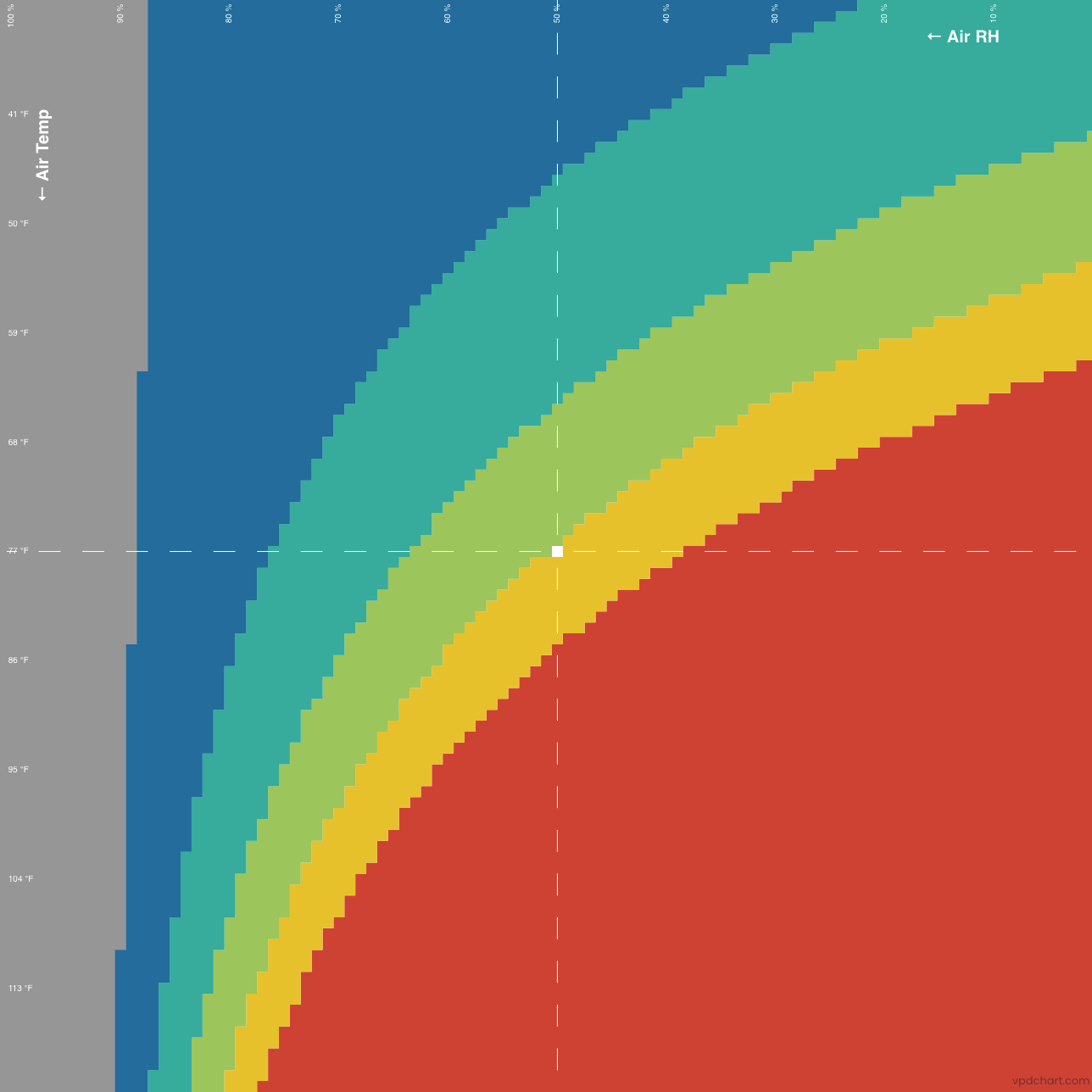Vapor pressure deficit (VPD) chart & calculator for horticulture in controlled environment. Cannabis, tomatoes, leafy greens, cucumber.

vpdchart.com
Leaf Temp under Dew Point: Danger Zone (Plant Disease)...COLOR GRIS
VPD under 0.4: Danger Zone (Under Transpiration)...COLOR VIOLETA
VPD from 0.4 to 0.8: Early Vegetative Growth / Propagation (Low Transpiration)...COLOR CIAN
VPD from 0.8 to 1.2: Late Vegetative / Early Flower (Healthy Transpiration)...COLOR VERDE
VPD from 1.2 to 1.6: Mid / Late Flower (High Transpiration)...COLOR AMARILLO
VPD over 1.6: Danger Zone (Over Transpiration)...COLOR ROSA
What is VPD?
Vapour Pressure Deficit (VPD), is an advanced metric that combines air temperature, leaf temperature, and relative humidity (RH) into a single unit of pressure.
How to calculate VPD?
VPD = VPleaf - VPair
VPleaf = 610.7 * 107.5*Tleaf/(237.3+Tleaf) / 1000
VPair = 610.7 * 107.5*Tair/(237.3+Tair)/1000 * RH/100
VPleaf - vapor pressure of the leaf (canopy) in kPa
VPair - vapor pressure of the air in kPa
Tleaf - leaf temperature in Celsius
Tair - air temperature in Celsius
RH - air relative humidity
VPD - vapor pressure deficit in kPa
Or simply, use the VPD chart and calculator.
You need a thermometer/hygrometer to measure the grow room temperature, RH and ideally an infrared thermometer, so you can measure the canopy temperature.
If you don't have an infrared thermometer, position your thermometer's remote probe at canopy level and take the reading after a few minutes, or assume that leaf temperature is 2°C cooler than air temperature.
Why is VPD important?
VPD expresses how temperature and relative humidity actually affect the plants - growth, stress and diseases.
VPD is a great indicator of plant transpiration rate.
Transpiration is necessary for photosynthesis, nutrient uptake, and plant cooling.
Plant stress is brought about by either excessive transpiration (high VPD values) or the inability to transpire adequately (low VPD values).
Therefore, VPD can help growers make decisions about irrigation, heating / cooling and dehumidification in their grow room / greenhouse.
What is the ideal VPD?
The ideal VPD range varies with the crop species and the stage of growth.
Currently, the ranges in the chart are for cannabis, but soon other plant species will be added.
What if VPD is too low ?
Humidity is high and plants are unable to evapotranspirate enough water to enable the transport of nutrients to cells, even though the stomata may be fully open.
Some plants may even exude water through special leaf tip or edge structures (hydathodes or water glands), forming drops, in a process called guttation.
In cases where the VPD is extremely low, water may condense onto leaves and other plant parts.
This can provide a medium for fungal/mold growth and disease.
Plants are unable to evaporate water and turgor pressure within the cells can cause splitting and cracking of fruits.
What if VPD is too high ?
Humidity is low and the rate of evaporation from the leaves can exceed the supply of water into the roots.
This will cause the stomata to close and photosynthesis to slow or stop.
The leaves might be at risk of high temperature injury since evaporative cooling is reduced due to the lack of water to evaporate.
To avoid injury and death from wilting, many plant species will either curl their leaves or orient them downward in an attempt to expose less surface area to the sun.
This can significantly reduce the growth rate and quality of crops.
How to control VPD?
To increase the VPD, moisture must be removed from the air, or the moisture holding capacity of the air must be increased by raising the temperature.
Moisture removal can be accomplished by using dehumidifiers (expensive), or by replacing moist air with drier air (typically through ventilation).
This is the standard practice for avoiding direct condensation onto crop or greenhouse surfaces.
To decrease the VPD, operate fog or misting devices to add water vapor to the air, or cool the air.
Both would reduce VPD level and the evapotranspiration stress in the crop.

